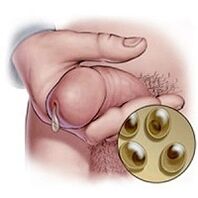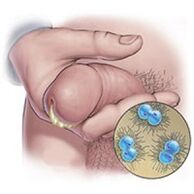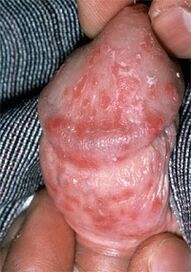
In men, discharge from the genitals is a discharge from the urethra and is the secret of the preputial glands located at the top of the genitals, under the foreskin. The ejaculatory duct, prostate ducts, urethra and bulbourethral glands open into the urethra.
In a healthy man, only urine and discharge flow from the urethra. This is a physiological discharge from the penis and should not cause any discomfort. Unfortunately, this is not always the case.
For various reasons, men's health is compromised and abnormal secretions are formed instead of normal secretions, or urine and sperm change.
Options of physiological secretions
Criteria for normal ejaculation according to the functions of the organs of the genitourinary system:
- Urine - clear, from straw to golden-yellow, practically odorless, without flakes or other inclusions;
- The secretion of the prostate has a viscous consistency and a whitish color, with the smell of a specific sperm;
- Ejaculation: sperm from the ejaculatory duct mixes with secretions from the urethral, Cooper's (bulbouretral) and prostate glands, acquires a grayish-white color and mucous consistency;
- Fresh smegma from the preputial glands is like thick white fat; may turn yellowish or greenish over time.
Preputial lubrication - smegma - is continuously released under the inner layer of the foreskin and accumulates in the coronal groove of the penis. The lubricant contains oil and bacterial residues, is evenly distributed and reduces friction between the foreskin and the scalp. The maximum activity of the preputial glands is characteristic of adolescence, with age, secretion decreases and stops completely in old age.
If you ignore the rules of personal hygiene, smegma can accumulate under the folds of the foreskin. In this case, the fat part of the lubricating oil is oxidized, and the protein part is broken down (in fact, it decomposes), and the masses turn green and have an unpleasant odor. The same process occurs with phimosis, when it is not possible to completely free the head of the penis from the folds of skin and remove the smegma due to the fusion of the foreskin. Accumulation and breakdown of lubricating oil can lead to chronic balanitis and balanoposthitis (inflammation of the foreskin and head of the penis), which increases the risk of developing tumors.
Mucous, colorless discharge from the urethra, bulbourethral and urethral glands. Ejaculation data appear in men with libido-related arousal. The discharge of clear mucus aims to lubricate the urethra and improve sperm permeability. The amount of secretion varies from small to abundant, these parameters are associated with individual characteristics of the organism and the frequency of sexual activity. After long-term abstinence, the volume of secretions increases.
Contamination is the spontaneous release of non-sexual sperm. Usually rising testosterone levels appear in the morning. It depends on the age and intensity of sexual activity: in boys during adolescence, in adult men - with irregular or infrequent sexual intercourse.
Prostatorea, discharge of a small amount of clear mucus from the urethra with grayish-white inclusions. Occurs after tension in the abdominal muscles (for example, with constipation) or after urination. The secret is a mixture of sperm and prostate discharge, an increase in volume and opacity may be signs of prostatitis.
Pathological discharge
In men, the causes of genital discharge can be sexually transmitted diseases, tumors, non-specific inflammation of the genitourinary system, various injuries, medical manipulations or operations.
Pathological discharge from the urethra is different from normal:
- By volume (too much or too little, perhaps moderate);
- In color and transparency (white to yellow-green, cloudy);
- With impurities (blood, pus, pieces of mucus);
- Consistencies (too thin or too thick and sticky);
- By smell (sour, rotten, fish);
- According to the frequency of occurrence (permanent or episodic discharge, depending on the time of day);
- Urination, sexual arousal, alcohol, spicy and spicy foods.
The nature of the discharge depends on the cause of the disease, the state of the immune system, the accompanying diseases, as well as the severity and duration of inflammation (acute or chronic).
If the amount, density or color of the discharge changes, and there is an unpleasant odor, it is recommended to consult a doctor and perform tests. It is not worth diagnosing on its own, it is very difficult to correctly diagnose the disease with just one symptom.
Penile discharge associated with STDs

Mucous: clear discharge, viscous and in small amounts, found in chronic forms of chlamydia, mycoplasma or ureaplasma urethritis. Microscopy reveals a moderate amount of leukocytes in the secretions (the norm is up to 4 cells in one field of view).
Mucopurulent: white discharge, transparent; observed in the exacerbation phase with chlamydia, ureaplasmosis and mycoplasmosis. In chlamydial infections, they accumulate at the head of the penis, as if "sticking" to the skin.
With the pathologies described above, secretions come from the urethra itself, because microorganisms irritate the mucous membrane of the urethra and the body tries to "wash" it.
It seems that the secret of white seems to cover the head. It is marked by chlamydia, candidiasis. In the first case, a film is formed, in the second - an empty cheese bloom.

Purulent discharge with an unpleasant odor is characteristic of gonorrhea. They are sticky, thick, yellow or greenish in color, have a putrid odor. Microscopic examination of the material shows epithelial cells of the urethra, many leukocytes.
Symptoms associated with gonorrheal urethritis: persistent and profuse discharge; pain, itching and burning are especially severe when urinating.
In sexually transmitted diseases, combined infections that combine several pathogens at the same time are often observed. Gonorrhea and trichomoniasis are accompanied by chlamydia, mycoplasmosis and ureaplasmosis are usually in pairs. The symptomatology of such diseases differs from the classical manifestations, and urethral discharge can take on a completely different character. Therefore, for the final diagnosis, modern analytical methods with a high degree of reliability are used, rather than the characteristics of the discharge.
Non-specific (non-venous) inflammation
The cause of non-specific inflammation is its own microflora, which is conditionally pathogenic and is activated only when the body has problems with the immune system. Streptococci and staphylococci, Candida and E. coli fungi are always on the surface of the skin and mucous membranes, but they begin to actively multiply and suppress beneficial bacteria after hypothermia, prolonged stress, uncontrolled antibiotic treatment, radiation courses. and chemotherapy.
Non-gonorrheal (non-specific) urethritis. Inflammatory discharge is small, appears in the urine in the form of mucopurulent cords or lumps, appears at the very beginning of the disease. Symptoms in the form of burning and itching during urination are less pronounced than in gonorrhea, but the urge is frequent and does not bring relief. With an increased infection, first the bladder becomes inflamed, then the ureters and kidneys; Discharge with a mixture of red blood appears.

Candidiasis (stomach), fungal infection of the urethra. It usually develops against the background of suppression of the immune system after a course of antibiotics, chemotherapy or radiotherapy; Sexual transmission of candidiasis in men is rare. It is characterized by a sour-smelling whirling discharge combined with itching and burning during urticaria (urination) and ejaculation (discharge), and may be accompanied by dull pain in the groin, pubis, and lower back.
Gardnerellosis of the urethra. The fishy smell of the discharge is characteristic; they are sparse, yellowish-white or greenish. According to some classifications, gardnerellosis is called STD, but sexually transmitted infection with gardnerella is more interesting in men. In fact, this disease is associated with a violation of the normal microflora, ie dysbiosis. Immunocorrectors and probiotics (lactic acid bacteria) are used in treatment.
Balanoposthitis, inflammation of the foreskin. Locally, abundant purulent discharge is observed, a mixture of mucus is possible. Edema and hyperemia (redness) of the prepuce leaves are always accompanied by headaches of the penis.
With prostatitis, a cloudy discharge appears at the end of urination, profuse discharge - in the acute period of inflammation; less and white - with the transition to a chronic form of the disease. Prostatitis is usually complicated by difficulty urinating and a weak erection, in severe cases - up to anuria (incomplete urination) and impotence.
Non-inflammatory discharge

Spermatorea - secretion in the form of passive flowing sperm, occurs without sexual intercourse or masturbation, without a feeling of orgasm. The causes are some diseases of the nervous system, spinal injuries, chronic stress and any long-term inflammation of the genital area. Spermatorea is associated with impaired innervation and decreased vas deferens tone.
Hematorrhea, staining. It is often seen during bougienage, with lesions of the urethral canal obtained after inserting a catheter or taking a smear from the mucous membrane. In these cases, the blood is fresh, without clots, the amount is small, the bleeding stops quickly. When small kidney stones or sand pass, blood is released during or immediately after urination, hematorrhea is accompanied by very severe pain (kidney colic). Hematuric hemorrhage in the form of glomerulonephritis (inflammation of the glomeruli of the kidneys) is accompanied by edema and consecutive high blood pressure, the appearance of protein in the urine.
In malignant tumors of the prostate gland, urethra, or bladder, a brown discharge of blood or mucus clots with a mixture of pus. Brown mucus may form during wound healing in mucous membranes and is secreted by polyposis of the urethra and / or bladder.
Prostatorea is a secretion of the prostate gland from the urethra. Occurs in chronic prostatitis, prostate adenoma, innervation disorder (neurogenic bladder).
Examination algorithm in case of pathological discharge from the penis

- Examination of the perineum, genitals, foreskin and glans. The purpose is to detect deformities of the genitals, their traces of injury, signs of external inflammation, discharge, rash, etc. Traces of discharge are sometimes visible on the canvas.
- Palpation of the inguinal lymph nodes, assessment of their condition: size, warmer or colder than the surrounding tissues, painful or non-painful, soft or tight, mobile or sticky to the skin, the presence of ulcers above.
- finger examination of the prostate; Prostate massage through the rectum and obtaining secretions for microscopic examination. It is recommended to avoid urinating for 1-2 hours before the massage. In the case of prostate adenoma, its lobes grow approximately evenly, dense threads are felt. Uneven growths and their consistency are typical for a malignant tumor, and clotted blood may be released from the urethra during palpation of the prostate.
- Material - smear for microscopy and culture. When examined under a microscope, blood stains, epithelium, sperm, fat deposits, and some pathogens (Escherichia coli, gonococci, gardnerella, yeast) are seen in the stained smear. An increase in the number of leukocytes is characteristic of acute urethritis or exacerbation of chronic inflammation, eosinophils - urethritis with allergies. Erythrocytes are found in severe inflammation, tumors, genitourinary tract infections, urolithiasis. Too much epithelium is a sign of chronic urethritis, urethral leukoplakia. Sperm cells in the sperm are in the smear, in the urethra - mucus, prostatorea - lipid grains. For the content of the information and the reliability of the results, the ointment is taken no later than 3 days after the topical application of antibiotics, antifungals and disinfectants. If antibiotic treatment is systemic, the course should last at least 3 weeks. Do not wash before taking the smear, try not to urinate for 2-3 hours.
- General clinical analysis of blood, blood for sugar - in the morning, on an empty stomach. Extended urinalysis (morning portion, immediately after sleep).
- ultrasound of the prostate gland, bladder and kidneys; CT and urography.
If the manifestations of genital inflammation are severe, the patient is prescribed broad-spectrum antibiotics immediately before the test results are obtained. Action is taken to hospitalize with heavy bleeding and to stop the bleeding. Confirmation of the suspicion of a malignant tumor can only be the result of a biopsy, the final diagnosis is made on the basis of histological examination.
Important:
- Penile discharge is the only symptom that cannot be guided when making a diagnosis.
- Independent appointment of the farm is not allowed. medications, even if the manifestations appear to be specific to a particular disease.

























